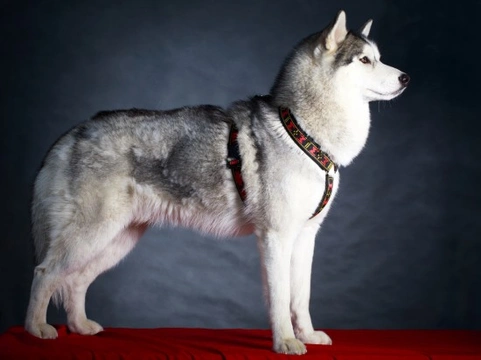
Siberian Husky colours, and commonly confused breeds
The Siberian Husky is a large, distinctive dog with an even larger personality! Famous for their wolf-like appearance and strong desire to run for hours on end, the Siberian Husky can make a most rewarding companion and running partner for fit owners who like to spend a lot of time out of doors, but they can be a handful and need an experienced owner and trainer. The Husky is one of the most active dogs around, and they will not thrive in a sedentary lifestyle, instead having a tendency to become destructive and take themselves off for walks and runs if you are not providing enough of them!
Most dog lovers think they could instantly recognise a Siberian Husky due to their unusual wolf-like appearance, but there are actually several dog breeds that physically resemble the Husky, and with which they are often confused! Added to this, the Husky can be seen in a reasonably wide range of coat colours, and with various different eye colours too, so all Huskies certainly do not look alike!
Read on to learn more about all of the possible coat and eye colour variances of the Siberian Husky, plus some of the similar-looking dog breeds that they are often confused with.
Siberian Husky eye colours
Many Siberian huskies have piercing pale blue eyes, which contribute to their somewhat mystical and wolf-like appearance! However, blue is not the only possible Husky eye colour, as there are plenty of other possible shades too! The Siberian Husky’s eyes might be:
- Both blue
- Both brown
- One blue and one brown
- Brown flecked with blue
- Blue flecked with brown
- Occasionally in the rare albino Husky, the eyes may appear to be red
Siberian Husky coat colours
While many people think that Huskies can only be grey or white and grey, in reality the Siberian Husky can be seen in almost any colour or colour combination and still be classed as a breed standard Husky.
Huskies also have different pattern styles and pattern colour combinations that vary from dog to dog, and so a reasonably wide range of different Husky appearances are possible! Some of the most common are:
- White, but not albino; usually the undercoat is a different shade, covered by the white
- Grey, in various different shades and graduations
- Black Huskies usually have points in another colour, or a differently coloured undercoat
- Red, again in various shades
- Any combination of white, grey, red and black in a mixture of top coat and undercoat, facial markings, or a differently coloured belly
- Albino
- Silver and white, which is a grey undercoat with white on top
- Saddleback markings, where the hairs are tipped with black, and a different colour appears prevalent on the head, haunches and shoulders
- Sable, which is a red-tinged brown shade, accompanied by a black nose
- Light red, a gingery colour with a white, orange, red or yellow stomach
- Copper is a darker colour graduation of the light red
- Agouti, an unusual coat that appears to consist of bands of different colours
The pattern and colour combinations of the Siberian Husky are almost infinitely variable!
Commonly confused breeds
There are various other large Spitz-type dog breeds that are easily confused with the Husky by the untrained observer! Three of the breeds that are most commonly confused with the Siberian Husky are the Alaskan Husky, the Alaskan Malamute, and the Northern Inuit Dog
The Alaskan Husky
The Alaskan Husky isn’t strictly classed as a purebred dog, and there are no breed standards or guidelines associated with them. They are most commonly kept as sled-racing dogs, and the aptitude and ability to race are more important than the bloodline. The Alaskan Husky often shares ancestry with the Siberian Husky, but the Alaskan version tends to be leaner and slightly shorter, with a more compact appearance.
The Alaskan Malamute
This is the dog that is most commonly mistaken for the Husky! However, the Malamute is generally significantly larger than the Husky, weighing around 20lb more like for like, and standing taller.
The tail of the Alaskan Malamute curls over their backs in the typical Spitz-dog style, while the tail of the Husky should be straight. Colour and pattern types of the two breeds are often very similar, but the size difference and the shape of the tail should give the breed away!
The Northern Inuit Dog
The Northern Inuit Dog is classed as a hybrid dog and not a pure breed, but they are becoming increasingly popular. They are the types of dogs used to portray the fearsome Direwolves in the TV series Game of Thrones.
The Northern Inuit Dog shares Husky breeding, and is composed of a mixture of Siberian Husky, German Shepherd and other Inuit dog breeds. Because of the make-up of their mixture, the appearance can vary between different dogs of the type, but if you can spot some German Shepherd there in the mix, the chances are you are looking at a Northern Inuit and not a Siberian Husky!



